| ILFORD Sportina Rapid |
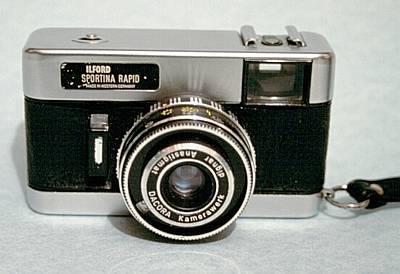 |
||
|
|
||
|
The Sportina Rapid camera range was a (near) instant loading camera, introduced by Ilford on a trial basis in SW England and S Wales during Spring 1965. The 1965 launch of the Ilford Rapid cameras was 'encouraging' (Camera magazine editorial, March 1966) to the extent that they were made available nationwide during 1966. The full range of Sportina cameras (see below) may not have arrived until 1966. The following description refers to the Sportina Rapid at the time of its announcement in Amateur Photographer for 28th April 1965. Apertures on the Sportina were set automatically according to the film speed; typical figures being f12.5 for b&w and f6.3 for 64ASA colour. The lens was a 46mm 3-element Dignar, focussing 1m to infinity. The focussed distance setting can be seen in the cut out window around the front of the lens mount (at 8 o'clock in the image above). Shutter settings were made according to weather symbols; "sunny" gave 1/125, "overcast" gave 1/60 and "flash" gave 1/30th sec. The flash shoe had a 'hot' centre contact. The Sportina Rapid flashgun can be seen here. Construction of the Sportina was a combination of plastic and satin chromed metal parts, and the size was 115 x 75 x 55mm. The price was £9.17s.9d (£9.89p) with a case 19s 10d extra (99p). In Practical Photography magazine for April 1966, the Sportina Rapid was advertised to be on sale throughout the UK and was then priced at £8.19s.6d (£8.98p), s small reduction on the 1965 'trial release' price. As the 'Rapid' name implies, this camera utilised the Rapid film system, as pioneered by Agfa in 1936 for their Karat camera, giving 12 exposures 24x36mm per cassette. The Karat system was itself developed from the 'Memo' cassette introduced by Ansco, Agfa's associate company in the USA, during the mid-1920s. The 35mm cassette, as eventually became the industry standard, was brought out by Kodak in 1934 to compliment the release of their first Retina camera. Agfa relaunched their old Karat cassette in the mid-1960s to counter the Kodak 126 Instamatic cartridge. The 'new' Agfa system was called the 'Rapid' system. An article by Eric Dugdale in Photographica World No.101 vol 3 for 2002 describes the Rapid cassette system in some detail, including the 'T' projection on the cassette which 'told' the camera what speed film had been loaded (25-400ASA); the length of the leg of the 'T' was longer with faster film. |
||
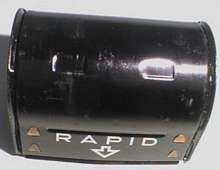 |
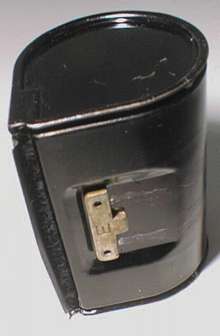 |
The Rapid cassette alongside has an 'E' tag, meaning that the vertical 'leg' of the 'T' section is 2mm (measured from the underside of the bar) and designates the film as 64ASA. The 'A' tag was just a plain bar and signified a 25ASA film. The 6mm long leg of an 'N' tag signified a 400ASA film. The leg length had a tolerance of +/- 0.05mm. |
|
|
A 'Rapid' camera used two cassettes. The unexposed film went into the right hand chamber, beneath the wind-on lever, and an empty cassette was placed in the left hand chamber. The film was wound from right to left, opposite to the conventional 35mm film movement. The use of two cassettes gave the security that inadvertent opening of the camera back did not destroy more than perhaps 1 or 2 exposures. This was a feature of the 126 Instamatic system, so would have been necessary in any rival system. | |
| Ilford introduced 3 films in Rapid cartridges to 'feed' this and other Rapid film cameras. Ilford's (Rapid cassette) b&w film (presumed to be FP3) was priced at 4s.6d (22.5p), 64ASA Colorprint was 17s.6d incl. processing and contact prints (87.5p), a new service introduced by Ilford for their colour print processing at the time, and 64ASA Super Colorslide was 17s.6d, including processing and slides returned in plastic mounts and 'Quick-look' plastic viewing sheets with pockets for 12 slides per sheet (another innovation by Ilford in Spring of 1965). | ||
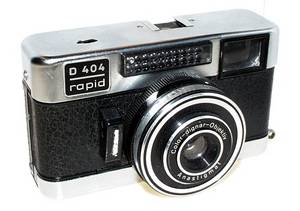 |
From adverts in Amateur Photographer (21st January 1970, Dollonds) it seems that a range of Sportina cameras finally emerged, including a basic Sportina Rapid I (Dacora equivalent D101), with a sale price, new, of £4.11s (£4.55p), a Sportina Rapid II (Dacora equivalent D202), a Sportina Rapid III (Dacora equivalent D303) at £10.10s.6d (£10.53p) and a Sportina Auto Rapid IV (Dacora equivalent D404, as left), priced at £15.15s (£15.75p). | |
|
|
The Ilford Sportina Auto-Rapid (pictures by David Muggleton). The original instruction booklet,
date code M65 (M is a mystery as the date code normally runs
A=January to L=December), can be viewed as a pdf file by clicking
the picture. |
|
 |
It has a f3.9 40mm anastigmat DACORA Color-Dignar lens and a selenium cell 'electric eye' which automatically sets the correct exposure. "Simply turn the yellow index dot on the inner rig (on the lens surround nearest the camera body) to AUTO for trouble-free shooting (at 1/100th sec shutter speed over the range of available apertures from f3.9 downwards)". Focussing is by turning the front milled edge lens surround so that a pointer appears against a symbol for close-ups (6feet, 1.8m), groups (12feet, 3.65m) and distant views (35 feet, 10.7m). The distance in feet can be read through a small window below the lens, which moves in an arc beneath the lens to show different distances as the focussing ring is rotated. The focussing range spans 3.5feet to infinity. Looking through the viewfinder, there is a coloured dot at the top which turns from green to red if there is insufficient light. If it is red, you are advised to use flash. This requires a capless bulb flashgun to be mounted in the accessory hot-shoe, which provides electrical connections without the need for a separate flash lead. Turn the yellow index dot on the lens surround away from AUTO to the lightening flash symbol. This fixes the aperture at f8 and the shutter speed to 1/40thsec, giving correct exposure at about 9feet with Ilford's Colorslide or Colorprint 64ASA film when using an AG1B flash bulb. |
|
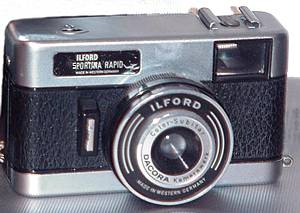 |
A flash gun made specially for the Sportina Rapid was available (Amateur Photographer magazine 'Lighting and Flash Guide, 1st Nov 1967) priced £1.9s (£1.45p), though the gun could equally be used with most any camera, since it provided both a standard 3mm coaxial PC plug as well as a 'hot-shoe' connection.
|
|
|
|
This camera, purchased by David Muggleton from an Austrian ebay vendor, is an interesting 'cross' between a Dacora 101 Rapid (see the Dacora D404, four illustrations above) and the Ilford Sportina Rapid, immediately above. It appears to be genuine, as Andy Holliman shows a similar (but not identical) version in his book, page 189. Andy's version has 'Sportina Rapid' beneath the lens, whereas the one shown here says 'Made in Western Germany'. |
|
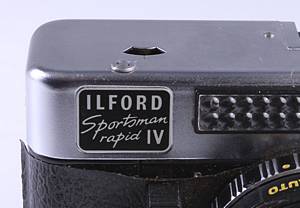 |
The pictures left and right are shown courtesy of Fris Goosselink of Zwolle - the Netherlands. They show a Ilford Sportsman rapid IV, clearly another naming of the similar (probably identical) Ilford Sportina Auto Rapid and Dacora D404 rapid, see above. The Ilford Sportsman rapid was probably never sold in the UK; the fact that this model was found in Holland suggests that country may have been its main market place. |
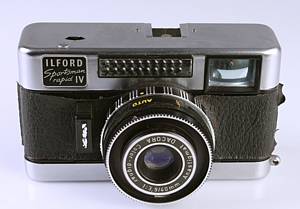 |
| According to Fris, the Ilford Sportsman Rapid doesn't appear in the usual camera collectors books e.g McKeown's and Kadlubek, but I found it in Andy Holliman's book "Ilford, Faces, People and Places, The Cameras of Ilford Limited 1899-2005" on page 193, where Andy also shows this same camera with a 40mm f3.9 Color Subitar instead of the 40mm f3.9 Color-dignar lens. | ||
|
|
||
|
|
||
